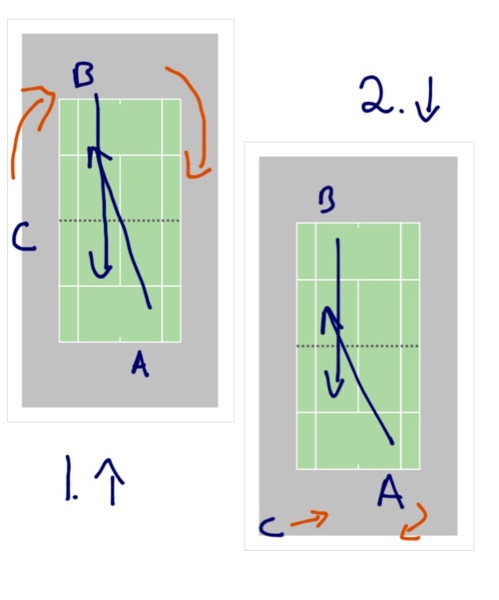Steal This Drill: Figure 8 Variation With Three Players
 Friday, February 3, 2012 at 08:37AM
Friday, February 3, 2012 at 08:37AM  CAtennis
CAtennis  Here are 2 variations on the Figure 8 drill (i.e., where one player goes cross-court but another goes down the line. CAtennis.com would like to extend our appreciation to Mr. Roy Coopersmith for, once again, suggesting the following variations on this staple tennis drill. One of the issues with the Fig. 8 drill is that it seems to work best in a 1-on-1 practice. However, as evidenced by the following, one can easily incorporate the Figure 8 drill into 3-on-court workouts.
Here are 2 variations on the Figure 8 drill (i.e., where one player goes cross-court but another goes down the line. CAtennis.com would like to extend our appreciation to Mr. Roy Coopersmith for, once again, suggesting the following variations on this staple tennis drill. One of the issues with the Fig. 8 drill is that it seems to work best in a 1-on-1 practice. However, as evidenced by the following, one can easily incorporate the Figure 8 drill into 3-on-court workouts.
Variant 1 (Figure 1 on the left): In this variant, Player A hits cross-court and Player B hits down the line. Player C is at the net post. The drill starts by having Player A feed. After Player B makes contact SIX (6) times, Player C jumps in Player B's spot and Player B runs to the opposite net post from where Player C was standing. Then, after Player A hits SIX (6) shots, Player B replaces Player A and Player A rushes to the net post that was originally manned by Player C. In other words, all players have the opportunity to hit TWELVE (12) shots in a row and then get a brief respite at the net. So, to summarize, the players hit and then rotate clockwise. Depending on the levels of the players, they can either hit FOUR (4) shots and move, SIX (6) shots or even EIGHT (8) shots and move.
Variant 2 (Figure 2 on the left): In this variant, Player B is by herself and hits down the line (or cross court). Players A and C hit SIX (6) shots each and then substitute in and substitute out. This is a great drill because Player B can really focus on hammering the ball down the line (or cross court) without "feeling bad" about making her practice partners move. The two practice partners (A and C) hit only a few shots and then get a brief break so they can (or should be able to) maintain a higher intensity and better quality drill.
What we like about these drills - particularly if the players possess different styles of play - is that all players get to "see a different ball" coming from their practice partners and have to adjust to the various shots while in the middle of the point. Accordingly, these are great drill for incorporating into a team format such as a high school or college practice.






